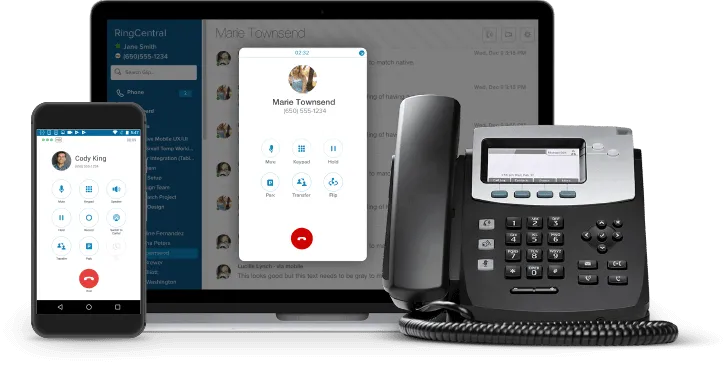What is VoIP?
VoIP refers to Voice over Internet Protocol, sometimes also known as internet or broadband phone. VoIP is a telecoms solution that enables users to make and take phone calls over the internet, in real-time.
It involves protocols working in combination to provide an internet telephony service that’s akin to a regular phone line or PSTN (public switched telephone network).
The difference between a VoIP phone system and a landline service is the fact that VoIP is inherently more flexible and mobile than a traditional telephone network. Because voice calling functions are delivered via the internet, Voice over IP allows users to connect and collaborate anywhere and anyhow—via their smartphones, laptops, or desktop computers.
Benefits of VoIP
With VoIP little expensive hardware is required, and there are fewer ongoing maintenance costs. With traditional on-premises phone systems, users can pay thousands of pounds for onsite hardware and need to invest in regular upkeep of the network.
With VoIP there’s just one network to manage, with voice and data transmitted over the same internet connection—so the old phone network can become redundant.
If you’re expecting a big volume of inbound calls you may need extra lines. A VoIP system makes it easy to add new ‘phone lines’, since the lines are virtual. Compared with calling in an engineer to add physical lines as is the case with traditional telephone systems.
VoIP offers free long distance calling or calls charged at a nominal fee, while traditional landlines often involve costly international calls which are paid for by the minute.
With traditional telephone networks, business features are often an expensive add on. With VoIP, useful business features like voicemail, call transfer, and call forwarding come as standard.
With VoIP you can make calls using ‘softphones’ which are mobile apps or programs installed on a mobile phone or computer. Their interface replaces traditional business phone handsets, and they can be touchscreen or keyboard oriented. Users typically use a headset and microphone, and they enable employees to deal with clients and customers across multiple devices.
Work Anywhere. Productivity has no limits.
The Definitive Guide to a VoIP Phone System
We offer free trials to see how it could work for you.
How do I set it up?
Setting up a RingCentral system is simple and quick. Your system will be configured and fully equipped according to your business needs. Once you’ve opted for RingCentral, you can simply plug your phones into a high speed internet connection or log on to RingCentral on a PC, and you’re ready to start making and taking calls—and more.
To get the most from RingCentral, firstly, determine the features you'll need from your phone system—e.g., video calling or IVR (interactive voice response)--so you know the right package to choose. Also, consider how many people will be using the service.
Then, check your system is compatible in terms of:

1. Your internet connection
It’s essential to check your internet bandwidth to make sure it can cope with RingCentral’s high quality calls, so you will need to carry out the following tests:
- A capacity test to help you identify the number of VoIP calls you can make on your broadband connection.
- A quality test to establish what VoIP calls between your desktop and RingCentral will sound like when using the service in reality.
2. Modem configuration
Your modem must be in IP pass-through or bridge mode. Contact your Internet Service Provider (ISP) for instructions on how to do this.
3. Router configuration
Find your router and configure it as per instructions. It may be that you need to buy a new router, but only if the current one is not on RingCentral’s list.
Then it’s time to get ready to start those conversations.
4. Plug in your phones (optional)
Attach handsets to phone bases using provided cords (if applicable). Connect your phone to the A/C adapter if you’re not using Power over Ethernet (PoE). Plug the Ethernet cable into the SW port of the LAN on the phone and plug the other end of the Ethernet cable into the switch or router. Now your phone will download automatically and run the configuration when it detects an internet connection.
Don’t worry when the phones keep restarting—this is all part of the process and will happen several times—just make sure not to unplug the cables from the phones.
You’ll know your phone is online when it displays the date and time set, on the extension the phone is assigned to. You can check your status via RingCentral’s app, too.
Of course, you don’t need phones at all, if you don’t want to use them. You can simply log into the RingCentral app on your PC, laptop, tablet, or mobile phone.
What equipment will I need for VoIP calls?
The exact equipment you need will depend on which VoIP provider you’re using, but in general you’ll need a fast internet connection, VoIP software, and an IP telephone if you wish to use a physical handset.
If you’re using VoIP for business use, you’ll need a strong connection. The higher the volume of calls you make and receive, the more bandwidth you’ll require.
The choice of router is important because you’ll need an option that delivers speed, connectivity, and security.
There are only a few other pieces of equipment you need. One is a computer or other device on which to run the VoIP software. That device can also act as a Private Branch Exchange (PBX) server. This will enable you to make internal calls in the workplace. You can also make and receive external calls via a softphone on your chosen device.
IP phones could be a good choice, too, even though they’re not absolutely necessary. Alternatively you could opt for softphones only or upgrade your traditional phone with a VoIP adapter.
If you’re set on keeping traditional telephony, you will also require a VoIP gateway, and service providers can generally help with this.
RingCentral works on Mac (desktop), Linux (desktop), and Windows (desktop), as well as on Android, iPhone, and Ipad (mobile).

Can I use VoIP for my home?
With more people working from home, there’s been a need to transfer the capabilities of an office based phone system into a work from home solution.

When talking about VoIP, many people think it’s solely a service used by businesses. However, the majority of people now have home internet and run a data network which is smaller than that of an office.
That means residential users can also benefit from having a high quality, inexpensive VoIP phone service. Some independent providers offer great features and low prices.
RingCentral offers solutions for small businesses all the way up to enterprise level, and enables those working from home to have as close to an in-office experience as possible when it comes to communications.
By adopting a cloud based system it’s easy for a small business to offer employees the flexibility and mobility of having a business phone number they can take anywhere.
VoIP phone vs. conventional phone
Landline phones or conventional phones connect via physical switch boxes that connect calls. The downside is that this kind of analog connection limits users to basic features like call waiting or voicemail.

VoIP phones on the other hand rely on the internet to connect calls. That means they can access a more useful set of features including automatic call forwarding and conference calling.
When employees are working remotely, a software-enabled VoIP phone can be used on a desktop, laptop, tablet, or smartphone. Basically whenever the VoIP software is installed users can turn that device into a VoIP phone. A VoIP phone allows home workers to work more efficiently while they are away from the office.
Benefits of using VoIP at home
Residential VoIP may not offer all the features you can get with an office-based service, but it’s very attractive when compared to a traditional landline.
Home VoIP comes with a far lower price tag compared to a traditional phone service.

Home VoIP has a lot more features than an old-fashioned landline, for example zero restrictions on long distance calling, smart call routing, and virtual numbers.
You can generally keep your existing phone number.

There are no hidden fees or metered calling charges, everything is charged at one rate by your provider.

You can customise your phone service to your exact requirements
Can I use VoIP for my business?
A lot of business communication is still done via phone calls, which is why VoIP systems are becoming more and more popular. They’re cheaper to run than landlines and provide a streamlined service, meaning start-ups and small businesses can compete with big brands.
There are two types of VoIP systems—those for business and those for consumers. VoIP for consumers has basic features including a virtual phone number, voicemail, and caller ID.

Business VoIP has additional features including:
- Auto-attendant
- Call forwarding
- Conference calls
- IVR (interactive voice response)
- Presence information
- Phone directories
- CRM integration
While you may only need a few basic features to start with, as your business grows you can grow your VoIP capabilities. You may want to switch up to hosted VoIP, too, which offers scalability and ongoing technical support.
Hosted VoIP
Unlike on-premises VoIP, hosted VoIP provides companies with a complete phone service.
Instead of having to build and maintain one or a number of servers, a hosted VoIP provider takes care of everything via their data centres, so businesses require less onsite hardware—and benefit from many more calling functionalities—with nil maintenance costs.
With analog phone systems, phones are connected via a PSTN (Public Switched Telephone Network). With on-premises VoIP, phones connect to an internal server on-site before data gets transmitted over the internet. In the case of hosted VoIP, phones connect via VoIP servers hosted in the cloud.

Business benefits of using a VoIP phone system
A VoIP service only needs a calling device, internet connection, and VoIP software to work. This is a straightforward system to set up requiring minimal downtime for employees.
VoIP services aren’t fixed to any particular location, so employees can use their mobile phones as an extension of their workplace phones. This is a big benefit for companies with remote or hybrid workers.
VoIP offers more than just the ability to make and take calls, it comes with a selection of add-on features including video conferencing, messaging, call routing, and much more besides.
VoIP is significantly cheaper than a landline phone service with free international calls as standard. Installation costs of hardware and software are minimal, and far cheaper than that of a landline based system.
For VoIP calling, all that’s needed is an internet connection so businesses can have as many lines as they want.
Just one fixed monthly cost makes it easier to manage financially, and with one provider supplying both data and voice, companies can experience greater technological efficiencies.

What is a VoIP service provider?
Do I need a VoIP service provider?

What do I look for in a VoIP service provider?
The ability to host and join audio and video conferences from anywhere.
A business grade level of Voice over IP that integrates with other systems. A good VoIP provider will be able to integrate with third party apps like Dropbox and Google Calendar with ease.
The ability to mine your third party systems for new insights into how customers behave, how they feel about your business, and also what their core demographics are.
A host of extra features such as screen sharing, scheduling, and calendar integrations—as well as the ability to build your own custom apps and workflows.
Call management features that can deal with high volumes of calls coming into a specific set of numbers—e.g., a service desk—and deal with spikes in demand during holidays. In this scenario a VoIP service provider that offers call handling features like call queuing to distribute calls and route to appropriate agents is vital.
A competitively priced service. While cost shouldn’t be the chief factor when choosing a provider, there’s no point opting for a VoIP service provider you can’t afford. Luckily some providers, such as RingCentral, have a fantastic selection of features with different ranges of services to suit different budgets.
A versatile range of VoIP services as well as softphone components (apps that act like phone features and functionality on mobile devices or PCs).
Enough capacity to grow and adapt as your company expands. Check any solution can scale at will, and look at the price implications for this.
Collaboration tools. Full service VoIP providers will offer a range of collaboration tools that your employees can access via a single unified communication app. This app can be supplied by a VoIP provider or via third party integrations. You can expect to be provided with access to SMS texting, softphone components (apps that act like phone features and functionality on mobile devices or PCs)
A guaranteed minimum uptime. RingCentral promises up to 99.99% uptime so that all your employees, both at the office and working remotely, can benefit from a reliable phone system whenever they need it.
RingCentral is just easy, easy, easy. I think I had 95% of the system for our entire company set up in about 10 minutes.
James Trazzera
General Manager, Intranet Technica

Choose RingCentral for your VoIP needs
RingCentral is a longstanding VoIP provider that has everything a company could look for in a cloud-based communications and PBX solution.
With everything from artificial intelligence (AI) to a wide variety of integrations—faxing, video conferencing, collaboration, and more—-RingCentral is an all-round Unified Communications as a Service (UCaaS) provider. Features include:
- Multiple collaboration functionalities
- A clear and user-friendly interface
- Superior mobile experience
- Lengthy list of third party app integrations so you can customise the platform according to your specific requirements. Integrations include Google, Microsoft 365, Salesforce, and more.
- Reasonable pricing structure which comes in four levels, complete with a free trial.
RingCentral also offers comprehensive deployment and management support via email, a help desk, a knowledge base, 24/7 live customer service, and chat.

RingEX™* plans for your small business
PAY ANNUALLY AND SAVE UP TO 38%.
- 750 Inclusive minutes per user
- On-Demand Call Recording
- Video meetings with up to 100 participants
- Internet fax
- Unlimited audio conferencing
- Multi-Level IVR
- Up to 24-hour meeting duration
- Quality-of-service reports
- Popular integrations including Microsoft 365, Google Workspace, Slack, and more
- 4000 Inclusive minutes per user
- Video meetings with up to 200 participants
- Device status reports
- Device status alerts
- Unlimited storage
Inbound Minutes
Freephone and Non-Geo number minutes
Freephone and Non-Geo number minute overage
ESSENTIALS
-
-
STANDARD
250 account per month
5p per minute
PREMIUM
1000 account per month
5p per minute
ULTIMATE
2000 account per month
5p per minute
Outbound Minutes
Mobile, Landline, Fax
Mobile, Landline, Fax overages per minute
ESSENTIALS
100 per user per month
4p per minute
STANDARD
750 per user per month
4p per minute
PREMIUM
2000 per user per month
3p per minute
ULTIMATE
4000 per user per month
3p per minute
- Answering rules
- Call forwarding
- Call transfer
- Call screening
- Call flip
- Call logs
- Presence
- Notifications
- Shared lines*
- Call park
- Intercom*
- Paging*
Premium with RingCentral Video (up to 200)
Standard with RingCentral Video (up to 100)
VoIP service FAQs:
- Place VoIP calls using Wi-Fi or 3G/4G LTE mobile data connections
- Receive calls directly from the app and forward calls to a cellular number
- Enjoy the same usability as with the Desktop app—e.g., have the ability to mute calls, put them on hold, switch caller, and use Bluetooth headphones
- Experience high quality audio thanks to the microphone calibration wizard, echo cancellation, and noise reduction
- Make multiple calls at the same time
RingCentral offers a number of cost-effective pricing plans. If you sign up for an annual subscription you can save up to 38%.
- On-demand call recording
- Internet fax
- Unlimited audio conferencing
- Video meetings for up to 100 people
- Multi-level IVR
- Integrations with the best known third party apps, including Microsoft 365, Google Workspace, and Slack
- 2000 minutes per user
- Video meetings for up to 200 people
- Single sign-on
- Hot desking
- Advanced call handling features, including whisper and barge
- Custom roles and permissions
- Automatic call recording
- Up to 8-digit extensions with site codes
- Integrations with major CRMs, including Salesforce, Zendesk, and more
- A developer platform
If you want to use your existing landline phone with RingCentral you can. You simply need an analog telephone adapter like the Cisco SPA-122 ATA. Connect the ATA to your router, then connect your analog phone to the ATA, so that the ATA can convert the digital signals into analog and vice versa.
VoIP calls, as with all internet communications, can be vulnerable to attack. VoIP works by transferring data over the internet with phone calls made digitally instead of over traditional phone lines. For that reason, it could be open to being hacked, if left unsecured. Calls can be intercepted or even used as an access portal into servers.
Because the sound of yours and others’ voices is converted into thousands of packets, factors can arise that affect those packets and cause problems with quality. The three most common factors affecting call quality are:
- Latency (also known as delay): This is the time it takes for a voice packet to reach its intended destination.
- Jitter: The variation in arrival rate of packets to destination points.
- Packet loss (also known as data loss): When certain packets are dropped by a router or discarded by a jitter buffer. This can lead to missing syllables or words during conversations.
To resolve call quality issues check whether you are the only one experiencing problems, or if it’s affecting other phones. Have there been any recent changes to your local network? For instance, has a file server been added, or a network or router changed? Or have you changed your internet service provider?
If no changes have been made, test your internet connection for speed so that it’s up to your provisioned level. Speed tests will show your ‘ping’, download, and upload times. You may have to upgrade your performance with your ISP.

